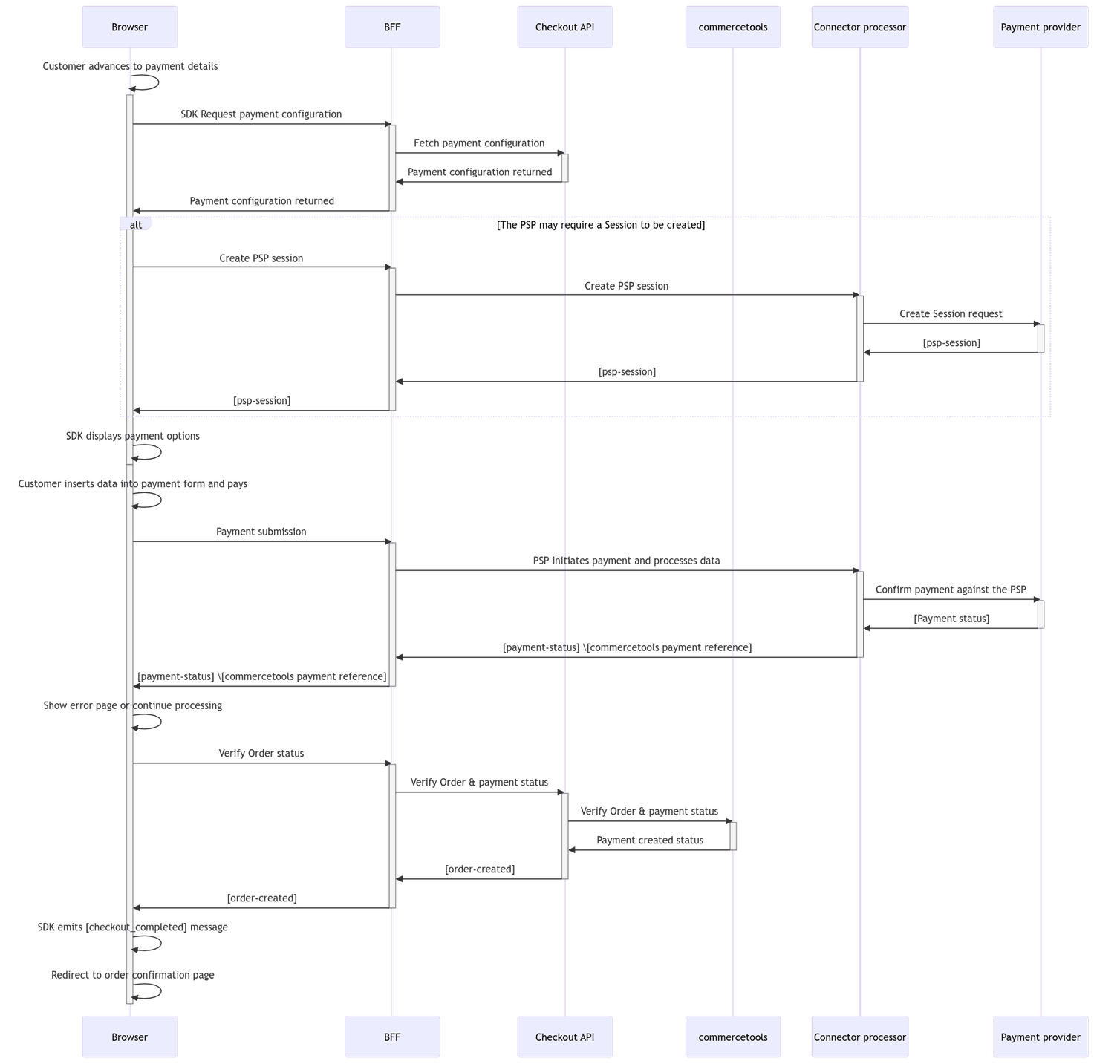How to initialize Checkout
- Complete Checkout mode uses the
checkoutFlowmethod. - Payment Only mode uses the
paymentFlowmethod.
Let's take a look at each in turn.
Complete Checkout mode
In the following diagram, we show the typical flow between the browser, Backend For Frontend (BFF), Checkout API, and Checkout Session when creating a Session and initializing the checkout.
After these steps, the browser should be displaying the checkout with the customer's Cart information. The following image is what we should expect to see in the browser at this stage. This example checkout is using the default styles.

Next, in the browser, the customer will add their shipping and billing information and apply any discount codes.

Next, let's go through the flow, where the customer requests the payment step and completes the checkout.
Call the checkoutFlow method and complete the checkout

Payment Only mode
The Payment Only mode offers greater flexibility by letting you independently manage the payment information user interface (UI). You choose when and where it appears, using a dedicated method. The rest of the checkout payment flow follows the same process as the Complete Checkout mode.
Best practices
To best utilize Checkout, we recommend the following best practices.
Checkout URL State
example.com/checkout/{cart-id}. We don’t recommend using the Session ID, because the lifetime of this ID is short (1 hour) and it’s not possible to generate a new Session ID from an expired session. However, we can create as many sessions as we may need, so long as we have the Cart ID.
The ability to generate a new session for the same Customer is crucial. Customers don't always convert in a single browsing session. By utilizing unique checkout URLs, businesses can leverage marketing tools to target customers and guide them back to the same checkout page multiple times, increasing the likelihood of conversion.checkout_completed Message (see the Complete Checkout mode diagram). This Message includes the Order ID, giving us enough information to query the Order and render the Order confirmation page.checkoutFlow or paymentFlow instances with little latency overhead.You can take a number of approaches with regards to the URL paths you create:
Use the same ID for checkout and Order confirmation URL
Some business requirements may necessitate using the same identifier for both the checkout and order confirmation pages. This could mean that we design our URLs to look like the following:
example.com/checkout/{cart-id}example.com/checkout/success/{cart-id}
Let's explore how to query the newly created Order using the checkout ID (in this case, the Cart ID).
Query the Order by Cart ID
GET /orders?where=cart(id="f1b7effe-9718-4e1b-b03f-3ebed5452267")GraphQL for Order resource:
query Orders {
orders(where: "cart(id = \"f1b7effe-9718-4e1b-b03f-3ebed5452267\")") {
results {
id
customer {
email
firstName
lastName
middleName
title
locale
salutation
version
id
createdAt
}
lineItems {
productId
name
quantity
}
}
}
}
Let's analyze the two primary approaches:
** Generating and assigning Order number before displaying the Confirmation page:**
-
Process:
- As soon as the customer completes checkout (
checkout_completedmessage emitted), you setOrderNumber on the Order. - Redirect the user to the order confirmation page, including the
orderNumberin the URL:example.com/checkout/success/{orderNumber}.
- As soon as the customer completes checkout (
-
Advantages:
- The order number follows your internal conventions and can be more human readable than a UUID.
-
Disadvantages:
- The process of setting the Order number will slightly delay the process of displaying the order confirmation page.
** Assigning Order number after confirmation (on demand):**
-
Process:
- Redirect the user to a generic order confirmation page, for example,
example.com/checkout/successafter the checkout completion. - On this page, initiate an asynchronous request to your backend.
- This backend request generates the custom order number and uses
setOrderNumberto assign it to the Order.
- Redirect the user to a generic order confirmation page, for example,
-
Advantages:
-
No additional latency in displaying the Order confirmation page.
-
Potential for user perception issues: the first time the customer views the order confirmation page, they will not see the orderNumber. This could cause some confusion for the customer.
-
Remember to carefully consider the trade-offs and potential issues associated with each approach. Thoroughly test your implementation to ensure data consistency and a smooth user experience.
Payment Only mode
When using the Payment Only mode, you must ensure that it is always the last step in the checkout process. This is because the Payment Only flow creates the Payment and Order.
Messages as events
The SDK exposes Messages as events. These events are very helpful for your application, providing insights into the checkout process. For example, you can receive notifications about errors, checkout completion, or any other relevant updates.
You can also leverage these events to create data layer events for your analytics tools. It is important to understand each of these Messages and handle them in your application code for a smooth customer experience.
Payment lifecycle
The payment lifecycle within your commerce solution involves several stages, from authorization to potential refunds. Understanding these stages and how to manage them is crucial for a smooth customer experience.
Refund
Refunds become necessary when you need to return captured funds to the customer. This could be due to:
- Customer returns
- Damaged or incorrect goods received
- Other situations requiring reimbursement
refundPayment action.Your responsibilities
orderState, which represents the state of the Order in the order processing workflow and indicates whether the Order is in an Open, Confirmed, Complete, or Canceled state. Updating the orderState typically requires explicit actions that are separate from the payment process, such as fulfilling the Order, shipping the goods, or handling returns. Because of this, you are responsible for determining when and how to update orderState.